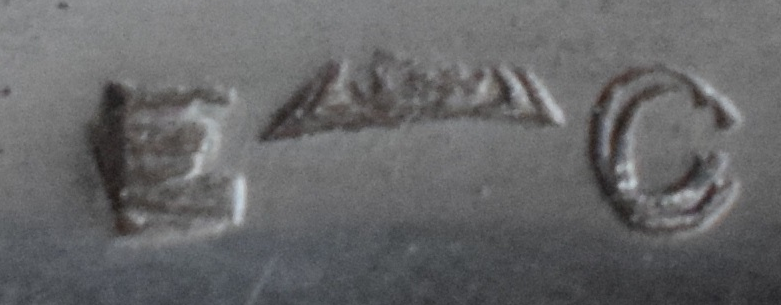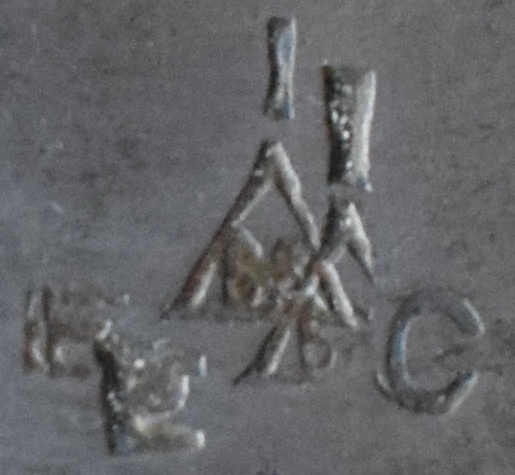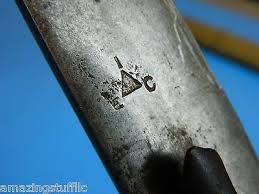| Author |
Message |
|
Patrick Vonk
|
 Posted: Fri 07 Apr, 2017 9:37 am Post subject: Antique tulwar marks Posted: Fri 07 Apr, 2017 9:37 am Post subject: Antique tulwar marks |
 |
|
Hi everybody,
A couple of days ago, I purchased an antique tulwar and I noticed some strange marks on the hilt and near the ricasso. They appear to read EIC, but I'm not sure what to make of them. The only other post that appeared to discuss the same marks didn't give a definitive answer (http://www.vikingsword.com/vb/showthread.php?t=12931), so I was hoping some of you would be able to shed some light on it. As far as I know the letters don't stand for East India Company.
Regards,
Patrick
 Attachment: 250.56 KB Attachment: 250.56 KB

On the hilt
 Attachment: 267.36 KB Attachment: 267.36 KB

Near ricasso
 Attachment: 207.66 KB Attachment: 207.66 KB

 Attachment: 469.86 KB Attachment: 469.86 KB
[ Download ]
|
|
  |
 |
David Lewis Smith

|
 Posted: Fri 07 Apr, 2017 2:39 pm Post subject: Posted: Fri 07 Apr, 2017 2:39 pm Post subject: |
 |
|
Could you post photos of the whole blade please.
It might very well be an EIC, some of the antiques I have have 'arms rooms marks' that were added after the fact, at least two of the middle eastern and south central Asian swords I have were European blades originally
David L Smith
MSG (RET)
|
|
   |
 |
David Lewis Smith

|
 Posted: Fri 07 Apr, 2017 2:48 pm Post subject: Posted: Fri 07 Apr, 2017 2:48 pm Post subject: |
 |
|
It suddenly struck me "East India Company" though it does not look like any of the EIC logos or arsenal marks I have seen so I looked and came up with two things, first this discussion
http://www.vikingsword.com/vb/showthread.php?t=17903
and this photo from an Ebay sail.
I think you have an East India Company sword.
SCORE!
 Attachment: 7.86 KB Attachment: 7.86 KB

David L Smith
MSG (RET)
|
|
   |
 |
|
Patrick Vonk
|
 Posted: Sat 08 Apr, 2017 2:27 pm Post subject: Posted: Sat 08 Apr, 2017 2:27 pm Post subject: |
 |
|
| David Lewis Smith wrote: | It suddenly struck me "East India Company" though it does not look like any of the EIC logos or arsenal marks I have seen so I looked and came up with two things, first this discussion
http://www.vikingsword.com/vb/showthread.php?t=17903
and this photo from an Ebay sail.
I think you have an East India Company sword.
SCORE! |
Hi David, thank you for your insight and the hyperlink to the thread on Ethnographic A&A. This yielded some interesting information! By the way, a picture of the whole blade was in the last attachment to my post. You need to click 'download' and then you should be able to see the entire sword (the picture quality makes the blade appear a bit serrated, but it's not). Please let me know if you need more pictures, I'll happily share them.
Anyway, the hyperlink you added actually seems to suggest it's not an East India Company sword. As Jim McDougall puts it:
"As very astutely noted, these stamps are most certainly not 'genuine' East India Company marks. The EIC ceased after the Indian Mutiny in 1857, and by this time the variations of EIC balemarks had long since gone out of use. The use of the EIC rampant lion had been in place since around 1808, and sword blades were never marked with any EIC markings, it appears focus was on guns (though I have seen bayonets so marked). It seems that sword blades, as far as I have known, never bore any type of EIC letters or bale mark.
By the 1860s the use of EIG (East India Government)stamps became regularly used, but it seems unclear again whether any such stamps occurred on blades. It does seem as usual that firearms were stamped and one example with the Royal crown and EIG I found in my notes (date 1867) . I believe the EIG designation ceased after WWI. Most arms sent to India through official shipments went through ISD (India Stores Dept), but many were apparently sent privately it seems, as there are many variations and absence of such stamps.
These triangles with the EI (G?) do seem curious as they are so poorly applied and seem more the work of indifferent workers in 'official' capacity rather than the work of industrious modern vendors. The initials within the triangles are interesting and wonder if they might be a clue to where these might have been issued."
However earlier in the hyperlinked thread McDougall says the following: "As seen in the previous thread linked, these triangular stamps seem to have to do with issuance or inventory matters associated with post East India Co. British Raj. I believe many of these were probably associated with the paramilitary security and patrol forces often employed by large British commercial estates, firms and other such entities, as I mentioned with the railroad example in the thread."
Still not a definitive answer, but at least a suggestion what they were about. Now I'm really curious who put them there.
|
|
  |
 |
David Lewis Smith

|
 Posted: Sat 08 Apr, 2017 2:38 pm Post subject: Posted: Sat 08 Apr, 2017 2:38 pm Post subject: |
 |
|
One of the simple internet data mining techniques is to use google Image searches. I searched 'East India Company Tulwar' to find that.
It is hard to tell in the photograph. Does the blade look European to you?
A lot of my tulwar/ blades from Afghanistan have 'English' numbers on them. I will take a few snap shots for you, but I do not have any EIC or triangles.....
David L Smith
MSG (RET)
|
|
   |
 |
|
Patrick Vonk
|
 Posted: Sun 09 Apr, 2017 1:19 pm Post subject: Posted: Sun 09 Apr, 2017 1:19 pm Post subject: |
 |
|
| David Lewis Smith wrote: | One of the simple internet data mining techniques is to use google Image searches. I searched 'East India Company Tulwar' to find that.
It is hard to tell in the photograph. Does the blade look European to you?
A lot of my tulwar/ blades from Afghanistan have 'English' numbers on them. I will take a few snap shots for you, but I do not have any EIC or triangles..... |
You're right, Google Image Search is very useful and I had also used it already, but unfortunately it wasn't of much help this time.
My knowledge of what characterises Indian and European sabre blades is quite limited, so I'm not sure where it came from. All I can say it's not a wootz blade, it has a flaring tip (not too sure how common those are on Indian made blades), it has a broad fuller on each side, no maker's mark or numbers on the sword other than the two triangular EIC marks, and almost no distal taper until 2/3 down the blade where it narrows a lot at the false edge. The blade profile is actually very similar to the tulwar profile in this picture http://i0.wp.com/www.strongblade.com/blog/wp-..._Silho.jpg
Thanks in advance for taking snap shots of your tulwars. Even if I don't get to know exactly what the EIC mark stands for, your photographs could give me an idea of where my blade was made.
I've attached two more photographs of the whole blade, so maybe these, along with the information above could help you determine whether it's European or not. Your help is greatly appreciated!
 Attachment: 345.17 KB Attachment: 345.17 KB
[ Download ]
 Attachment: 220.99 KB Attachment: 220.99 KB
[ Download ]
|
|
  |
 |
|
Timo Nieminen
|
 Posted: Sun 09 Apr, 2017 3:16 pm Post subject: Posted: Sun 09 Apr, 2017 3:16 pm Post subject: |
 |
|
| Patrick Vonk wrote: | | My knowledge of what characterises Indian and European sabre blades is quite limited, so I'm not sure where it came from. All I can say it's not a wootz blade, it has a flaring tip (not too sure how common those are on Indian made blades), it has a broad fuller on each side, no maker's mark or numbers on the sword other than the two triangular EIC marks, and almost no distal taper until 2/3 down the blade where it narrows a lot at the false edge. |
Looks Indian. Profile, thickness, and fuller are all common enough on Indian-made blades, and all on the same blade too. I see no reason to suspect that the blade might be European.
That said, I don't know that much about the imported European blades, and thus whether European origin is plausible. It can be difficult to tell, even if the blade is a commonly-imported style, because blades were made locally in imitation of imported blades, down to copied maker's marks. I'm told that experts can tell whether European or Indian made given close examination, or even good photos, but I can't reliably (poor copies are often obvious, but good copies much less so).
"In addition to being efficient, all pole arms were quite nice to look at." - Cherney Berg, A hideous history of weapons, Collier 1963.
|
|
   |
 |
|
Patrick Vonk
|
 Posted: Sun 09 Apr, 2017 3:52 pm Post subject: Posted: Sun 09 Apr, 2017 3:52 pm Post subject: |
 |
|
| Timo Nieminen wrote: | | Patrick Vonk wrote: | | My knowledge of what characterises Indian and European sabre blades is quite limited, so I'm not sure where it came from. All I can say it's not a wootz blade, it has a flaring tip (not too sure how common those are on Indian made blades), it has a broad fuller on each side, no maker's mark or numbers on the sword other than the two triangular EIC marks, and almost no distal taper until 2/3 down the blade where it narrows a lot at the false edge. |
Looks Indian. Profile, thickness, and fuller are all common enough on Indian-made blades, and all on the same blade too. I see no reason to suspect that the blade might be European.
That said, I don't know that much about the imported European blades, and thus whether European origin is plausible. It can be difficult to tell, even if the blade is a commonly-imported style, because blades were made locally in imitation of imported blades, down to copied maker's marks. I'm told that experts can tell whether European or Indian made given close examination, or even good photos, but I can't reliably (poor copies are often obvious, but good copies much less so). |
Thank you for the information Timo. Sounds like it might be very difficult then to determine its origin even with David's photographs. The only thing that can be said with reasonable certainty at this point, is that it's a genuine antique.
Do you happen to know the names of a couple of experts on tulwars?
|
|
  |
 |
|
Timo Nieminen
|
 Posted: Mon 10 Apr, 2017 2:59 am Post subject: Posted: Mon 10 Apr, 2017 2:59 am Post subject: |
 |
|
You could try posting on the Ethnographic Weapons forum at http://www.vikingsword.com - the best place I know to find tulwar experts.
"In addition to being efficient, all pole arms were quite nice to look at." - Cherney Berg, A hideous history of weapons, Collier 1963.
|
|
   |
 |
|
Patrick Vonk
|
 Posted: Mon 10 Apr, 2017 5:47 am Post subject: Posted: Mon 10 Apr, 2017 5:47 am Post subject: |
 |
|
| Timo Nieminen wrote: | | You could try posting on the Ethnographic Weapons forum at http://www.vikingsword.com - the best place I know to find tulwar experts. |
Alright, I'll also try my luck there. Thanks for the info Timo.
|
|
  |
 |
|
Mark Moore
|
 Posted: Mon 10 Apr, 2017 7:08 am Post subject: Posted: Mon 10 Apr, 2017 7:08 am Post subject: |
 |
|
Hal Siegel, of Therion Arms, was big into antique and ethnographic pieces at one time. I believe he is a member here. He might have some insight on this.  ....McM www.therionarms.com ....McM www.therionarms.com
''Life is like a box of chocolates...'' --- F. Gump
|
|
  |
 |
|
Patrick Vonk
|
 Posted: Tue 11 Apr, 2017 5:54 am Post subject: Posted: Tue 11 Apr, 2017 5:54 am Post subject: |
 |
|
| Mark Moore wrote: | Hal Siegel, of Therion Arms, was big into antique and ethnographic pieces at one time. I believe he is a member here. He might have some insight on this.  ....McM www.therionarms.com ....McM www.therionarms.com |
Thanks Mark, I'll try to contact him.
|
|
  |
 |
|
|
You cannot post new topics in this forum
You cannot reply to topics in this forum
You cannot edit your posts in this forum
You cannot delete your posts in this forum
You cannot vote in polls in this forum
You cannot attach files in this forum
You can download files in this forum
|
All contents © Copyright 2003-2025 myArmoury.com — All rights reserved
Discussion forums powered by phpBB © The phpBB Group
Switch to the Basic Low-bandwidth Version of the forum
|

